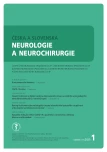Third ventricle bowing as a radiological marker of non-communicating hydrocephalus and successful endoscopic ventriculocisternostomy
Authors:
T. Krejčí 1,2; O. Krejčí 1; M. Mrůzek 1,2; Z. Večeřa 1,2; R. Lipina 1,2
Authors‘ workplace:
Neurochirurgická klinika FN Ostrava
1; LF OU, Ostrava
2
Published in:
Cesk Slov Neurol N 2021; 84/117(1): 81-84
Category:
Short Communication
doi:
https://doi.org/10.48095/cccsnn202181
Overview
The radiological finding of the third ventricle deformation (known as bowing) is considered as a simple and effective marker capable of predicting the presence of obstructive hydrocephalus and the success of endoscopic ventriculocisternostomy. In patients with bowing and hydrocephalus, endoscopic ventriculocisternostomy should be the first choice of treatment. With the exception of children under the age of 6 months for whom, according to our experience, the predictive value of bowing fails. The aim of this study was to summarize our experience and at the same time literary knowledge dealing with this topic.
Keywords:
ydrocephalus – endoscopic ventriculo cisternostomy – third ventricle – predictive value
Sources
1. Krejci T, Mruzek M, Vecera Z et al. Prediction of success and failure of endoscopic third ventriculostomy. Cesk Slov Neurol N 2015; 78/111 (4): 413–422.
2. Dlouhy BJ, Capuano AW, Madhavan K et al. Preoperative third ventricular bowing as a predictor of endoscopic third ventriculostomy success. J Neurosurg Pediatr 2012; 9 (2): 182–190. doi: 10.3171/2011.11.PEDS11495.
3. Kehler U, Gliemroth J. Extraventricular intracisternal obstructive hydrocephalus – a hypothesis to explain successful 3rd ventriculostomy in communicating hydrocephalus. Pediatr Neurosurg 2003; 38 (2): 98–101. doi: 10.1159/000068053.
4. Börcek AÖ, Uçar M, Karaaslan B. Simplest radiological measurement related to clinical success in endoscopic third ventriculostomy. Clin Neurol Neurosurg 2017; 152: 16–22. doi: 10.1016/j.clineuro.2016.11.006.
5. Kehler U, Regelsberger J, Gliemroth J et al. Outcome prediction of third ventriculostomy: a proposed hydrocephalus grading system. Minim Invasive Neurosurg 2006; 49 (4): 238–243. doi: 10.1055/s-2006-950382.
6. Krejčí T, Krejčí O, Večeřa Z et al. The role of third ventricle bowing in the success of endoscopic third ventriculostomy in pediatric and adult patients. Clin Neurol Neurosurg 2019; 187: 105554. doi: 10.1016/j.clineuro.2019.105554.
7. Vogel TW, Bahuleyan B, Robinson S et al. The role of endoscopic third ventriculostomy in the treatment of hydrocephalus. J Neurosurg Pediatr 2013; 12 (1): 54–61. doi: 10.3171/2013.4.PEDS12481.
8. Foroughi M, Wong A, Steinbok P et al. Third ventricular shape: a predictor of endoscopic third ventriculostomy success in pediatric patients. J Neurosurg Pediatr 2011; 7 (4): 389–396. doi: 10.3171/2011.1.PEDS10461.
9. Wang Q, Cheng J, Zhang S et al. Prediction of endoscopic third ventriculostomy (ETV) success with preoperative third ventricle floor bowing (TVFB): a supplement to ETV success score. Neurosurg Rev 2020; 43 (6): 1575–1581. doi: 10.1007/s10143-019-01178-1.
10. Santamarta D, Díaz Alvarez A, Gonçalves JM et al. Outcome of endoscopic third ventriculostomy. Results from an unselected series with noncommunicating hydrocephalus, Acta Neurochir (Wien) 2005; 147 (4): 377–382. doi: 10.1007/s00701-005-0484-8.
11. Faggin R, Calderone M, Denaro L et al. Long-term operative failure of endoscopic third ventriculostomy in pediatric patients: the role of cine phase-contrast MR imaging. Neurosurg Focus 2011; 30 (4): E1. doi: 10.3171/2011.1.FOCUS10303.
12. Rekate HL, Nadkarni TD, Wallace D. The importance of the cortical subarachnoid space in understanding hydrocephalus. J Neurosurg Pediatr 2008; 2 (1): 1–11. doi: 10.3171/PED/2008/2/7/001.
13. Lipina R, Reguli S, Dolezilová V et al. Endoscopic third ventriculostomy for obstructive hydrocephalus in children younger than 6 months of age: is it a first-choice method? Childs Nerv Syst 2008; 24 (9): 1021–1027. doi: 10.1007/s00381-008-0616-6.
14. Sacko O, Boetto S, Lauwers-Cances V et al. Endoscopic third ventriculostomy: outcome analysis in 368 procedures. J Neurosurg Pediatr 2010; 5 (1): 68–74. doi: 10.3171/2009.8.PEDS08108.
15. Duru S, Peiro JL, Oria M et al. Successful endoscopic third ventriculostomy in children depends on age and etiology of hydrocephalus: outcome analysis in 51 pediatric patients. Childs Nerv Syst 2018; 34 (8): 1521–1528. doi: 10.1007/s00381-018-3811-0.
16. Kulkarni AV, Drake JM, Kestle JR et al. Predicting who will benefit from endoscopic third ventriculostomy compared with shunt insertion in childhood hydrocephalus using the ETV Success Score: clinical article. J Neurosurg Pediatr 2010; 6 (4): 310–315. doi: 10.3171/2010.8. PEDS103.
17. Durnford AJ, Kirkham FJ, Mathad N et al. Endoscopic third ventriculostomy in the treatment of childhood hydrocephalus: validation of a success score that predicts long-term outcome: clinical article. J Neurosurg Pediatr 2011; 8 (5): 489–493. doi: 10.3171/2011.8.PEDS1166.
18. Warf BC, Mugamba J, Kulkarni AV. Endoscopic third ventriculostomy in the treatment of childhood hydrocephalus in Uganda: report of a scoring system that predicts success: clinical article. J Neurosurg Pediatr 2010; 5 (2): 143–148. doi: 10.3171/2009.9.PEDS09196.
19. Kulkarni AV, Drake JM, Mallucci CL et al. Endoscopic third ventriculostomy in the treatment of childhood hydrocephalus. J Pediatr 2009; 155 (2): 254–259. doi: 10.1016/j.jpeds.2009.02.048.
20. Gianaris TJ, Nazar R, Middlebrook E et al. Failure of ETV in patients with the highest ETV success scores. J Neurosurg Pediatr 2017; 20 (3): 225–231. doi: 10.3171/2016. 7.PEDS1655.
Labels
Paediatric neurology Neurosurgery NeurologyArticle was published in
Czech and Slovak Neurology and Neurosurgery

2021 Issue 1
Most read in this issue
- Frontotemporal dementia
- COVID-19 and stroke
- Encephalocele in the Czech Republic – incidence, prenatal diagnostics and international comparison
- Carotid endarterectomy after intravenous thrombolysis and mechanical thrombectomy
